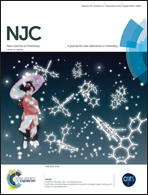Comprehensive insights into the structure and coordination behavior of thiosemicarbazone ligands: a computational assessment of the E–Z interconversion mechanism during coordination†
Abstract
Thiosemicarbazones (TSC) have been the subject of a large number of investigations, either because of their pharmacological effects in a wide variety of compounds or because of their intriguing and controversial coordination behaviour. These features make TSC derivatives significant, particularly in complexes and coordination chemistry. Because some of the TSC ligands have shown E–Z interconversion about the C![[double bond, length as m-dash]](https://www.rsc.org/images/entities/char_e001.gif) N double bond during the coordination process, a comprehensive study on the coordination mechanism of these TSCs has been conducted on several model molecules with the aim of applying it to other TSC derivatives, and also of providing new views on the complexation behaviour of these compounds. The density functional theory (DFT) computations (B3LYP/6-311++G(2d,p) and B3LYP/6-31+G(d)) have been used for these investigations. Initially, all the conformational and tautomeric structures were obtained and then the mechanistic studies were performed on the optimized structures. Additionally, the influence of terminal nitrogen substitution on the conformation of TSCs was also investigated. All possible mechanisms: rotation (direct isomerisation), inversion (lateral shift) mechanism, and tautomerization, which subdivides into two paths (catalysed and non-catalysed), were explored to reach the energy favoured mechanism. The DFT calculations reveal that the solvents have a strong impact on the E–Z isomerisation of TSCs in which the inversion mechanism is the most likely mechanism in aprotic (and less polar) solvents, whereas the catalytic tautomerization mechanism prevails in protic (and polar) solutions. This is because of the retardation and the acceleration effects of the protic solvent (and the acidic condition) on inversion and catalytic tautomerization mechanism, respectively. These findings are consistent with the experimental evidence obtained. Furthermore, because the E–Z isomerisation (and TSC binding modes) was under the influence of terminal N-substitution in several experiments (e.g., 3-methoxy salicylaldehyde and 2-oxo-1,2-dihydroquinoline-3-carbaldehyde TSC), the underlying reasons for this suspicious and contradictory behaviour have been also assessed and interpreted using the results obtained.
N double bond during the coordination process, a comprehensive study on the coordination mechanism of these TSCs has been conducted on several model molecules with the aim of applying it to other TSC derivatives, and also of providing new views on the complexation behaviour of these compounds. The density functional theory (DFT) computations (B3LYP/6-311++G(2d,p) and B3LYP/6-31+G(d)) have been used for these investigations. Initially, all the conformational and tautomeric structures were obtained and then the mechanistic studies were performed on the optimized structures. Additionally, the influence of terminal nitrogen substitution on the conformation of TSCs was also investigated. All possible mechanisms: rotation (direct isomerisation), inversion (lateral shift) mechanism, and tautomerization, which subdivides into two paths (catalysed and non-catalysed), were explored to reach the energy favoured mechanism. The DFT calculations reveal that the solvents have a strong impact on the E–Z isomerisation of TSCs in which the inversion mechanism is the most likely mechanism in aprotic (and less polar) solvents, whereas the catalytic tautomerization mechanism prevails in protic (and polar) solutions. This is because of the retardation and the acceleration effects of the protic solvent (and the acidic condition) on inversion and catalytic tautomerization mechanism, respectively. These findings are consistent with the experimental evidence obtained. Furthermore, because the E–Z isomerisation (and TSC binding modes) was under the influence of terminal N-substitution in several experiments (e.g., 3-methoxy salicylaldehyde and 2-oxo-1,2-dihydroquinoline-3-carbaldehyde TSC), the underlying reasons for this suspicious and contradictory behaviour have been also assessed and interpreted using the results obtained.


 Please wait while we load your content...
Please wait while we load your content...